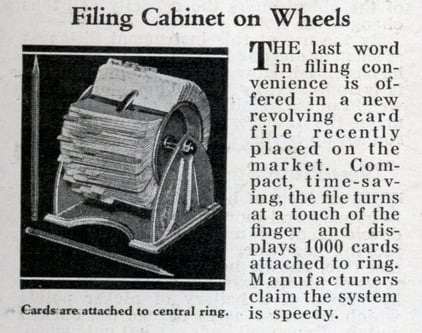 I noticed this old ad the other day and it made me laugh. I don’t know what year it was made but at the time, the best new idea in business automation apparently was the Rolodex. “The last word in filing convenience.”
I noticed this old ad the other day and it made me laugh. I don’t know what year it was made but at the time, the best new idea in business automation apparently was the Rolodex. “The last word in filing convenience.”
OK, well, maybe not so last.
I doubt that you are still using index cards to organize your contacts, but your organization’s approach to huddle boards may be just as outdated. In the same way that an electronic contact database has a ton of advantages over a Rolodex, digital huddle boards offer valuable benefits than paper notes pinned to a poster on the wall. Here are the top reasons to consider an upgrade.
1 – Digital Boards Are Available from Anywhere
The modern workforce is often distributed with people working from home either some or all of the time. In addition, the ease of collaboration has made it so that team members don’t necessarily need to work in the same location to be successful. Physical huddle boards have the obvious limitation that you have to be present to look at or interact with them. This is not the case with the latest huddle board software. It can reside in the cloud so that team members can access it anytime, from wherever they happen to be. Engagement with improvement can be sustained even if folks are working remotely, traveling, or if inspiration strikes after hours or on the weekend.
Listen to this Post and Subscribe to the Podcast:
2 – It is Easy to Manage Multiple Boards
Being able to set up as many boards as you like is a great advantage of the digital approach. Leaders who are involved in more than one team or department have access to all of the boards they need to see without constantly roaming the halls. You can also easily break improvement projects down into groups that make sense for each board. You can create boards based on the type of improvement, the goal of the initiative, the people involved, or any other grouping that makes sense for your organization or team.
3 – Improvement Work is Archived
One of the biggest problems with paper huddle boards is that they represent only the current state of improvement ideas and projects. It is a useful snapshot, but it doesn’t convey the full narrative of the department or team’s improvement work over time. Software designed for the purpose, on the other hand, creates a treasure trove of information about every attempt at positive change. People can search for past improvements that relate to what’s going on today and see if there are lessons that can be applied. Groups can take a look at what is happening in other parts of the organization to potentially duplicate successful improvements or piggy-back on current projects.
4 – Results Can be Assessed
The successful implementation of an improvement should not be considered the end of the project. You might be ready to move it off the board and move on to other things, but the impact of the improvement often won’t be fully realized for months or years. Physical huddle boards are not an effective way to measure the results of change, but digital ones are equipped to do exactly that for as long as you like. Impact measurement is essential because it helps keep employees and executives enthusiastic about improvement. It makes it a snap to justify necessary investment in improvement activities and it helps establish a logical priority for future improvement work. In addition to tracking financial metrics such as cost savings or additional revenue, you can also track non-financial benefits like better customer satisfaction scores, faster time to market, and improved safety.
5 – Improvement Happens Faster with Active Management
Paper huddle boards won’t remind team members when a task is due. They won’t alert managers when deadlines are missed or progress stalls. Daily huddles are a good way to sustain progress, but they don’t typically cover every ongoing project or check the status on all of the tasks that have been assigned. The digital approach makes that easy by providing notifications and alerts to everyone involved in improvement activities. Managers have insight into the progress of all projects and can jump in to remove roadblocks or provide coaching when needed.
Huddle boards have been an important part of improvement culture for decades. They are a powerful way to organize improvement work and serve to increase engagement and momentum. Those benefits are greatly amplified by choosing software that supports this approach to visual management.


Add a Comment